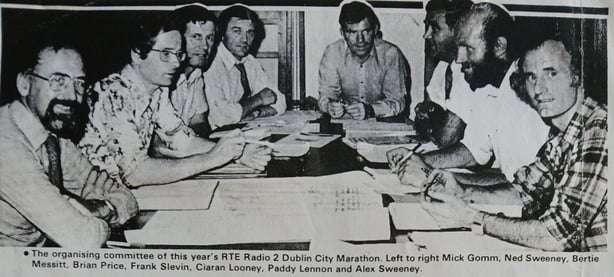Analysis: the champion runner and Olympian used his day job on the number 10 Dublin bus route to plot the course for the city's first marathon
The Dublin marathon has become an annual, inspiring and colourful fixture in the Irish sporting calendar since the inaugural race in 1980. But it may not have had the instant success were it not for Bertie Messitt. From serving as a bus conductor on the No.10 Dublin bus route to drawing up the route for the marathon around the city, Messitt has had a huge impact on the history of Dublin marathon and Irish athletics.
Born in Boghall, Bray in 1928, Messitt joined the British Army after the Second World War, where he took part in his first cross country race. He was posted in the Middle East and participated in one mile and three mile races. He began to race competitively upon his return to Ireland in the 1950s. Bertie trained by running from his home in Shankill to the Dublin Bus garage in Donnybrook, where he worked as a bus conductor on the No. 10 route.
We need your consent to load this rte-player contentWe use rte-player to manage extra content that can set cookies on your device and collect data about your activity. Please review their details and accept them to load the content.Manage Preferences
During his career, he held 16 national records in distances ranging from 3,000m to the marathon. HE was selected by the Olympic Council to represent Ireland in the marathon at the 1960 Olympics in Rome alongside his teammates Willie Dunne and George McIntyre. Lean, fresh faced and wearing a green vest with the number 58, Messitt was the frontrunner in the early stages of the race, which was famously won by Abebe Bikila, who ran the marathon barefoot and won Ethiopia's first Olympic gold medal.
Messitt competed in the European Athletics Championships in 1958 and was flag bearer for Ireland at the Championships in Belgrade in 1962, where he finished 13th out of a field of 28 athletes in the marathon. He was a member of Donore Harriers Athletics Club and remained active in athletics long after his international career ended. He formed an athletic club at the Dublin Bus garage in Donnybrook in the 1970s and was a founder of the Business Houses Athletic Association (BHAA), the body who launched the Dublin marathon.

The Evening Press newspaper stated at the time that "every detail from entry to the number of cups needed at drinking stations to the intricacies of timing have been thoroughly considered by a special committee". The organising committee members for the first marathon were Noel Carroll, Mick Gomm, Paddy Lennon, Ciaran Looney, Bertie Messitt, Brian Price, Frank Slevin, Alex Sweeney and Ned Sweeney. Messitt was the only one on the committee who had experience running a marathon and played a key advisory role.
We need your consent to load this rte-player contentWe use rte-player to manage extra content that can set cookies on your device and collect data about your activity. Please review their details and accept them to load the content.Manage Preferences
Dick Hooper from Dublin was the first winner and his prize was a piece of Dublin Crystal. He was given a tumultuous reception at the finish in Stephen’s Green by a huge crowd which included the Minister for Sport Jim Tunney, Lord Mayor Alderman Fergus O'Brien and Olympians Ronnie Delany and Eamonn Coghlan. Hooper went on to be the only person to win the race three times. The first winner of the ladies category was Carey May, who ran a world class 2:42:11 and was the first of 40 female finishers in the inaugural event.
All participants in the first Dublin City Marathon were presented with a plaque, which was made by Copperware Designs in Newry. It depicted a view of Dublin City incorporating landmarks such as the Ha’Penny Bridge, Liberty Hall and Custom House - some of which the runners passed by on their 26 mile marathon journey.
We need your consent to load this rte-player contentWe use rte-player to manage extra content that can set cookies on your device and collect data about your activity. Please review their details and accept them to load the content.Manage Preferences
The first route for the Dublin City Marathon was undoubtedly influenced by Bertie’s familiarity with the No. 10 bus route. The race started and finished at St Stephen’s Green and passed through Cabra, Finglas, Ballymun, Killester, Clontarf, Dollymount and Donnybrook. It was a conscious decision for the route to move through densely populated areas so that the event could take on a social significance, one that remains today.
The Dublin marathon has had a lasting impact on the city economically, culturally and socially. It is now a sports tourism event, attracting athletes and attendees from all over the world. It is not reserved for elite athletes, but is an event where everyone can be involved as volunteers or supporters. It's a success because the very first organising committee took great care in ensuring that the marathon was organised in a thorough and professional manner. And much of that was down to the valuable contribution of Bertie Messitt, a true veteran of the capital's marathon.
Follow RTÉ Brainstorm on WhatsApp and Instagram for more stories and updates
Disclaimer: The copyright of this article belongs to the original author. Reposting this article is solely for the purpose of information dissemination and does not constitute any investment advice. If there is any infringement, please contact us immediately. We will make corrections or deletions as necessary. Thank you.






